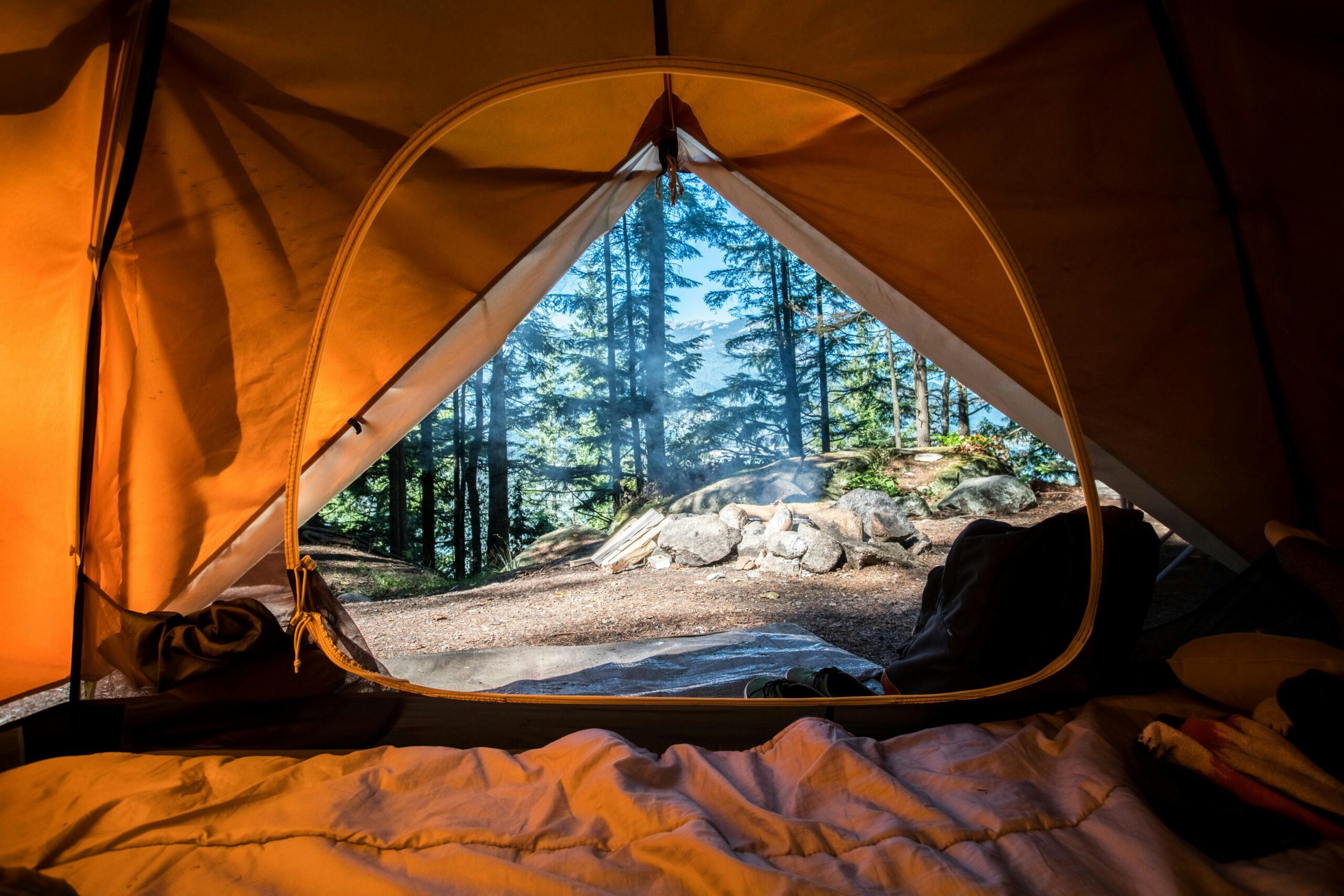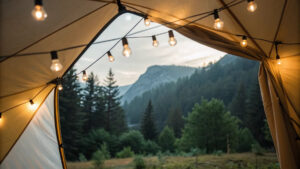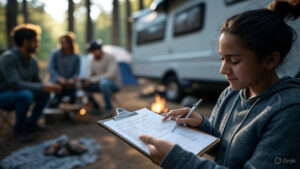First Time Camping? Here’s Exactly What to Take for One Night Outdoors
Packing for your first camping trip feels like solving a giant puzzle – trust me, I’ve been there! The excitement of spending a night under the stars often gets mixed with that nagging worry about forgetting something important. But here’s the good news: with some simple preparation, even one night of camping can turn into an unforgettable adventure.
My first camping trip taught me lessons I’ll never forget. These days, after hundreds of nights outdoors, I know exactly what makes the difference between a comfortable camping experience and a challenging one. The secret lies in packing smart – you’ll need essentials like a reliable headlamp (aim for at least 150 lumens), plenty of water storage, and a properly stocked first aid kit.
Let me share what I’ve learned over countless camping trips. This guide walks you through all the must-have gear for your first night outdoors. From choosing the right tent to setting up a basic camp kitchen, I’ll cover everything you need to know. Whether you’re completely new to camping or just need a quick refresher, my practical tips and tested gear recommendations will help you feel confident about your first outdoor adventure.
Essential Camping Gear for Beginners
Getting your gear right can make or break your camping experience – I learned this the hard way on my first few trips! Let me share the camping essentials I’ve discovered through years of trial and error, broken down into three key categories that’ll keep you comfortable outdoors.
Shelter and sleeping equipment
Your tent becomes your cozy wilderness home, so choosing the right one matters. Here’s something I always tell first-time campers: pick a tent rated for one more person than you plan to bring – you’ll thank me when you need space for your backpack and boots! A tent footprint and stakes aren’t optional extras – they’re absolute must-haves for a solid setup.
Sweet dreams outdoors need three key items:
- A 3-season sleeping bag that’ll keep you toasty spring through fall
- A sleeping pad (trust me, the ground gets cold!)
- Proper camping pillows (your neck will thank you)
My Tried-and-Tested Tent Picks:
Basic cooking tools
Nothing beats a hot meal at camp! After countless camping meals, here’s what I consider kitchen essentials:
- A reliable camping stove with enough fuel
- Basic cookware (one pot, one pan, eating utensils)
- Water containers (both for drinking and cleanup)
Pro Tip: I’ve found the Eureka stove paired with Stanley cookware gives you everything needed for camp cooking.
Lighting essentials
Good lighting changes everything at camp! From my experience, you’ll want a lantern pushing out 200-500 lumens for general camp lighting. Inside your tent, 60-100 lumens works perfectly.
My Favorite Light Sources:
Don’t forget spare batteries! I always pack a headlamp too – trying to set up camp or cook in the dark with a flashlight in your mouth isn’t fun (yes, I’ve been there!).
The right camping gear makes all the difference between a night you’ll want to forget and one you’ll always remember. After countless trips under canvas, I’ve learned that quality basics beat fancy gadgets every time. Start with a reliable tent, comfortable sleeping setup, and proper lighting – these three elements create the foundation for wonderful outdoor experiences.
Remember, you don’t need to buy everything at once. Focus on essential gear first, then build your collection as you discover what works best for your camping style. My first tent wasn’t anything special, but it kept me dry through some memorable storms and taught me exactly what to look for in my next upgrade.
Happy camping, fellow adventurers! There’s nothing quite like falling asleep under the stars with the right gear keeping you comfortable and safe.
Smart Packing Strategy
You know what can turn a perfect camping trip into a complete mess? Disorganized packing! I learned this lesson the hard way when I couldn’t find my headlamp during a pitch-black setup. A solid packing strategy makes all the difference between a smooth outdoor experience and a chaotic one. Trust me – a well-thought-out packing list becomes your best friend in the wilderness.
How to organize your gear
Let me share my tried-and-true organization system that’s evolved over countless camping trips. Start by dividing your gear into two main piles – must-have basics and nice-to-have extras. Then, grab some bins and sort everything by use – one for your kitchen gear, another for sleeping stuff, and definitely a separate one for those important safety items.
Pro Tip: Here’s a little trick I’ve picked up – keep your camping gear in labeled bins even between trips. I always tape a contents list on each bin, making it super easy to spot what needs replacing or restocking.
My Go-To Storage Solutions:
- Clear plastic bins (game-changers for finding stuff!)
- Hanging organizers (perfect for those small items that love to disappear)
- Compression sacks (your bulky sleeping bag’s best friend)
Speaking of space-saving, vacuum storage bags are absolute magic for puffy items. I once squeezed my winter sleeping bag down to carry-on size – talk about a space-saver!
Weight distribution tips
Getting your pack weight right isn’t just about comfort (though your back will thank you!). It’s crucial for staying safe and stable on the trail. The magic ratio I always aim for? About 80% of the weight sitting on my hips, with just 20% on my shoulders.
My Tried-and-True Packing Zones:
| Zone | What Goes Where |
|---|---|
| Bottom | Light stuff (sleeping bag, clothes) |
| Middle | Heavy gear (tent, food stash) |
| Top | Quick-grab items (snacks, rain jacket) |
Packing Rules I Live By:
- Heavy stuff goes right against your back
- Balance those sides (nobody likes walking sideways!)
- Lock everything down tight
Car camping? Focus on your five heaviest items first. I always nestle these right in the middle of my pack, snug against my back. This trick has saved my shoulders on many occasions!
Smart packing isn’t just about stuffing gear into bags – it’s about creating a system that works trip after trip. Through years of camping, I’ve discovered that organized packing becomes second nature once you find your groove. The time you spend organizing at home pays off tenfold when you’re setting up camp in fading daylight or searching for that one essential item you know you packed somewhere!
Remember, your packing strategy will evolve with experience. Start with the basics I’ve shared, then adapt them to fit your camping style. The most important thing? Just get out there and start camping – you’ll figure out what works best for you along the way.

Setting Up Your First Campsite
Setting up camp reminds me of solving a puzzle – every piece needs to fit just right! After countless nights outdoors, I’ve learned that your campsite’s location and setup can make or break your outdoor experience. Let me walk you through creating your perfect home away from home.
Choosing the perfect spot
Finding the right spot for your tent isn’t just about flat ground – though that’s definitely important! Look for a spot that’s slightly higher than the surrounding area. This simple trick has saved me from waking up in a puddle more times than I can count! Remember to camp at least 200 feet from any water sources to protect our beautiful wilderness.
My campsite selection checklist:
- Skip those tempting low spots and dried-up creek beds
- Watch out for widow-makers (those dangerous dead trees and branches)
- Point your tent door away from the wind – trust me on this one
- Use natural windbreaks like bushes (they’re nature’s wind shields!)
Step-by-step tent setup
Your tent is your wilderness palace, and setting it up right matters! Here’s my foolproof method that works every time:
- Clear away those pesky rocks and sticks, then lay down your groundsheet
- Face your tent’s strongest side into the wind (learned this one the hard way!)
- Gently push those poles through – never pull them
- Stake out corners at 45-degree angles for maximum stability
- Add your rainfly, lining up all seams perfectly
Pro tip: I always do a test run in my backyard before any camping trip. Nothing’s worse than figuring out tent setup in the dark or rain!
Creating a functional camp kitchen
A well-planned camp kitchen makes outdoor cooking pure joy! Keep your cooking spot about 10 feet from where you’ll eat, and maintain a safe distance from any campfire area.
My kitchen setup secrets:
- Arrange tables in an L or U shape (works like a charm!)
- Set up zones: prep here, cook there, clean over there
- Create a separate drink station (prevents the dreaded kitchen traffic jam)
Camp Kitchen Do’s and Don’ts (learned from experience):
My tried-and-tested gear picks:
Setting up your first campsite might feel overwhelming, but remember – every experienced camper started exactly where you are! My first setup wasn’t perfect (picture a slightly lopsided tent and a kitchen that looked more like organized chaos), but those early experiences taught me the most valuable lessons. These days, I can transform any suitable patch of ground into a cozy outdoor home in no time.
The key to successful camp setup? Take your time, follow the basic principles we’ve covered, and don’t worry if everything isn’t picture-perfect. Some of my most memorable camping experiences happened at sites that wouldn’t win any awards for style but felt just right for creating wonderful outdoor memories.
Photo by Alex Thompson on Unsplash
Safety Essentials for First-Time Campers
Safety isn’t the most exciting part of camping, but it’s definitely the most important! Through my years of outdoor adventures, I’ve learned (sometimes the hard way!) that being prepared for the unexpected makes all the difference.
First aid basics
My first aid kit has saved many camping trips! Here’s what I always pack for an overnight adventure:
- BZK-based antiseptic wipes (these sting less than alcohol wipes)
- Antibacterial ointment
- Various sizes of adhesive bandages
- Gauze pads (trust me, pack extra!)
- Medical tape that actually sticks
- Blister treatments (your feet will thank you)
Weather preparation
Mother Nature loves surprises! After getting caught in an unexpected storm (not fun!), here’s what I never camp without:
Must-Have Weather Gear:
- Quality rain gear (both jacket and pants)
- Cozy long underwear for chilly nights
- Warm insulated jacket that packs small
Weather Wisdom I’ve Learned:
- Always check weather forecasts before heading out
- Point your tent away from wind (learned this one the hard way!)
- Keep repair supplies where you can grab them quickly
Storm Safety Rules (that might save your life):
Emergency supplies
Sometimes things don’t go as planned – that’s why these items never leave my pack:
My Emergency Must-Haves:
- Map and compass (batteries die, these don’t)
- Emergency blanket (weighs nothing, saves lives)
- Water for 3-5 days (you’ll need more than you think)
Pro Tip: I always pack 2-3 meters of paracord and a meter of good duct tape – they’ve fixed more camping gear emergencies than I can count!
Safety might not be the most thrilling part of camping, but it’s the foundation of every great outdoor adventure. Through my years of camping, I’ve discovered that preparation isn’t about expecting the worst – it’s about ensuring you can focus on enjoying the best moments outdoors.
Remember, every experienced camper started as a beginner who probably forgot something important on their first trip (I certainly did!). The key is learning from each experience and gradually building your safety knowledge. Start with the basics we’ve covered, and you’ll be well-prepared for countless amazing nights under the stars.
Photo by Sarah Johnson on Unsplash
Top Recommended Camping Products
Let’s talk about gear! After countless nights under canvas, I’ve tested enough camping equipment to fill a small store. While fancy gadgets are fun, I’ve learned that quality basics make the biggest difference for new campers.
Best beginner tents
The Kuiu Mountain Star 2 Person Tent has become my go-to recommendation for first-time campers. Here’s why I love it:
| Feature | What Makes It Great |
|---|---|
| Setup Time | Quick 10-minute pitch (perfect when daylight’s fading!) |
| Space | Fits 2 adults without feeling cramped |
| Extra Features | That vestibule is a lifesaver for muddy boots |
| Weather Ready | Keeps you dry even in nasty weather |
Pro tip: Grab a footprint for your tent – it’s like insurance for your tent floor! Trust me, that extra layer has saved my tent from countless sharp rocks and soggy grounds.
Looking for something lighter? The Nemo Hornet Osmo might be your perfect match:
- Light as a feather at 2 pounds
- Roomy 20+ square feet (I can actually sit up in it!)
- Sets up faster than you can boil water
- Laughs in the face of wind and rain
Sleeping bag recommendations
My favorite discovery has been the Nemo Coda Genderless Endless Promise Down Mummy Bag:
| Feature | Why It’s Amazing |
|---|---|
| Warmth Rating | Cozy from 10-20°F (tested in some chilly nights!) |
| Weight | Just 2.2-2.8 pounds |
| Style | Roomy mummy design (no more feeling like a sardine) |
| Clever Design | Unzippable footbox for warm-feet freedom |
Pair it with the Therm-a-Rest BaseCamp Sleeping Pad:
- Self-inflates (no more getting dizzy blowing up your pad)
- Plush 2-inch thickness
- Keeps ground chill at bay
- Packs down surprisingly small
Essential camping tools
Here’s what’s earned a permanent spot in my camping kit:
Can’t-Camp-Without Tools:
- Multi-tool (mine’s fixed everything from tent poles to coffee pots)
- Rubber mallet (your tent stakes’ best friend)
- Compact broom set (because nobody likes a dirty tent)
- Duct tape (the ultimate camping miracle worker)
- Paracord (more useful than you’d think!)
Kitchen Must-Haves:
- Sturdy cutting board
- Collapsible sink (game-changer for dishes)
- Earth-friendly soap
- Scrubber (hot tip: pack two!)
- Plenty of trash bags
Nice-to-Have Luxuries:
- Dutch oven (nothing beats campfire stew)
- Camp coffee maker (because mornings need coffee)
- Ice cream maker (yes, really!)
- Clear storage bins (organization is your friend)
Quality camping gear doesn’t have to break the bank or fill a garage! After years of testing everything from budget basics to premium equipment, I’ve learned that the best gear is simply what works reliably for your camping style. Some of my most memorable camping trips happened with simple, dependable equipment that just did its job without fuss.
Remember, every seasoned camper started with basic gear and built their collection over time. Focus on the essentials we’ve covered, and let your camping experiences guide your future gear choices. The real magic of camping isn’t about having the fanciest equipment – it’s about getting out there and creating wonderful memories under the stars.
Final Thoughts – First Time Camping Essentials
Looking back at my first camping trip, I remember feeling overwhelmed by all the gear, preparations, and “what-ifs.” These days, after countless nights under the stars, I’ve learned that successful camping isn’t about having everything perfect – it’s about having the right basics and a sense of adventure!
The secret to enjoyable camping boils down to three key elements I’ve discovered through trial and error. First, your shelter setup needs to be solid – I’ve found the REI Base Camp 4 paired with quality sleeping gear creates a cozy home base. Second, smart packing (those clear bins are lifesavers!) makes everything from setup to breakdown smooth sailing. Finally, proper safety prep gives you the confidence to fully enjoy your outdoor experience.
Here’s something I tell every new camper – start with car camping at established campgrounds. Some of my favorite camping memories happened at simple sites just an hour from home! This approach lets you focus on mastering the basics without worrying about hiking distances or remote locations. Plus, having your car nearby offers peace of mind while you’re building confidence.
Remember, camping isn’t about Instagram-perfect setups or having the fanciest gear. It’s about disconnecting from the daily grind and reconnecting with nature. Pack thoughtfully, follow basic safety guidelines, and most importantly – have fun! That first night you spend under canvas might just be the beginning of a lifelong love affair with the outdoors.





